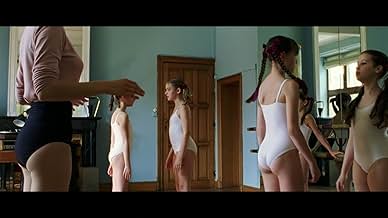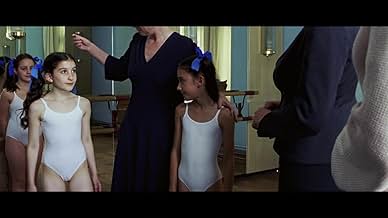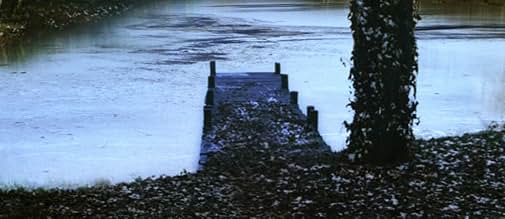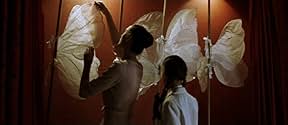IMDb-BEWERTUNG
6,8/10
6797
IHRE BEWERTUNG
Ein Blick in ein abgelegenes Internat für junge Mädchen.Ein Blick in ein abgelegenes Internat für junge Mädchen.Ein Blick in ein abgelegenes Internat für junge Mädchen.
- Regie
- Drehbuch
- Hauptbesetzung
- Auszeichnungen
- 8 Gewinne & 2 Nominierungen insgesamt
Empfohlene Bewertungen
There can't be many films that occupy your mind for many days afterwards, make you read the book they are based on, and then watch them again.
"Innocence" is one of those films and it is both beautiful and intriguing at the same time. It is based on a book by Frank Wedekind called "Mine-Haha or the corporeal education of girls", the only published fragment of his unfinished novel "Hildalla". It was first published in 1901 and although beautifully written it has much darker undertones than the film with references to a body cult of youth and natural beauty which would later become exploited by Nazi culture.
The film is very much a metaphor for a childhood world which is in many ways separate but also protected from that of adults. It plays in an isolated Girls School their children enter at the time when they start to make their own independent experiences of the world around them and ends with the onset of puberty and attainment of menarche, both symbolising the emotional and physical end of childhood. The cinematography is beautiful and reminded me in many ways of Tarkovsky with its symbolism and haunting images. However, the story can seem a little simplistic and linear times and often appears to demand more depth from the young child actors than they could possibly deliver.
Nevertheless this is a very interesting and thought-provoking film and well worth watching. The French dialogue often has a musical quality and as long as you're prepared to watch this in a calm and unhurried state of mind this is very rewarding and unusual cinematic experience.
"Innocence" is one of those films and it is both beautiful and intriguing at the same time. It is based on a book by Frank Wedekind called "Mine-Haha or the corporeal education of girls", the only published fragment of his unfinished novel "Hildalla". It was first published in 1901 and although beautifully written it has much darker undertones than the film with references to a body cult of youth and natural beauty which would later become exploited by Nazi culture.
The film is very much a metaphor for a childhood world which is in many ways separate but also protected from that of adults. It plays in an isolated Girls School their children enter at the time when they start to make their own independent experiences of the world around them and ends with the onset of puberty and attainment of menarche, both symbolising the emotional and physical end of childhood. The cinematography is beautiful and reminded me in many ways of Tarkovsky with its symbolism and haunting images. However, the story can seem a little simplistic and linear times and often appears to demand more depth from the young child actors than they could possibly deliver.
Nevertheless this is a very interesting and thought-provoking film and well worth watching. The French dialogue often has a musical quality and as long as you're prepared to watch this in a calm and unhurried state of mind this is very rewarding and unusual cinematic experience.
Offbeat? This film is so far removed from offbeat, that previous films described as offbeat are marching in military step unison. Innocence is a gorgeous composition of thought, sound and beauty which is utterly compelling to watch but challenges the viewing audience to a hard fought internal battle, raising questions within the viewer, in a William Blake-ish "Songs Of Innocence, Songs Of Experience" manner.
Undoubtedly the cinematography is some of the most striking that has been put to film certainly this side of the millennium, as Hadzihalilovic manages to compose wonderful shots of serene beauty within a hidden sense of malice and darkness. His symbolic use of colours is highly key to the understanding of the events, themes and emotions and aids the viewer immensely in being able to 'try' (and I emphasis the word) and dissect the layers of thought provoking connotations on the nature of innocence.
It's not always the most comfortable film to be viewing, as certain IMDb reviewers would hasten to claim it has "pedophilic tendencies", but I fear they're somewhat missing the point of the entire film; yes it is often at times difficult to view, but there is a purpose. William Blakes collection of poems on innocence and experience charts the replacing of the former with the latter. He shows us how innocence cannot be appreciated til you are experienced, but how experience completely taints any notion of innocence, and the same is with this precise film. These unsettling moments for us are only so because of the experience which we possess and have learnt throughout our existence, to the girls they don't see the same sins, pitfalls and traps we do, to them they are merely acting on instinct, as children do, in an innocent, cares- of the world-free way.
Thus the film charts the fall of innocence from the elder girls at the hauntingly constructed boarding school, and the continuing of the cycle through metamorphic symbolism, the circle of young life. Although it does make me question the use of the word "film". If I had but one criticism of the film, for all its mesmerising viewing and original premise it comes across more as a case study in innocence rather than a fully fledged story. While undeniably engaging and engrossing it lacks a certain spark, becoming more concerned with the ideas than the progression of any one story, to the extent where the ideas will be ringing in your head for days afterwards, but lacking a sense of resolution. Innocence would be an impressive debut solely on the basis of bravery alone for tackling such a notion, and so effectively, but the hallmarking of this 'case study' comes in the directors striking use of colours, symbolism and cinematography which I personally believe to have been unsurpassed in the films I've seen of recent years. Although you have been warned, the film is an intense experience which will not set well with everyone, but given that you have now been warned, so it's not as if you can claim you were innocent of that.
Undoubtedly the cinematography is some of the most striking that has been put to film certainly this side of the millennium, as Hadzihalilovic manages to compose wonderful shots of serene beauty within a hidden sense of malice and darkness. His symbolic use of colours is highly key to the understanding of the events, themes and emotions and aids the viewer immensely in being able to 'try' (and I emphasis the word) and dissect the layers of thought provoking connotations on the nature of innocence.
It's not always the most comfortable film to be viewing, as certain IMDb reviewers would hasten to claim it has "pedophilic tendencies", but I fear they're somewhat missing the point of the entire film; yes it is often at times difficult to view, but there is a purpose. William Blakes collection of poems on innocence and experience charts the replacing of the former with the latter. He shows us how innocence cannot be appreciated til you are experienced, but how experience completely taints any notion of innocence, and the same is with this precise film. These unsettling moments for us are only so because of the experience which we possess and have learnt throughout our existence, to the girls they don't see the same sins, pitfalls and traps we do, to them they are merely acting on instinct, as children do, in an innocent, cares- of the world-free way.
Thus the film charts the fall of innocence from the elder girls at the hauntingly constructed boarding school, and the continuing of the cycle through metamorphic symbolism, the circle of young life. Although it does make me question the use of the word "film". If I had but one criticism of the film, for all its mesmerising viewing and original premise it comes across more as a case study in innocence rather than a fully fledged story. While undeniably engaging and engrossing it lacks a certain spark, becoming more concerned with the ideas than the progression of any one story, to the extent where the ideas will be ringing in your head for days afterwards, but lacking a sense of resolution. Innocence would be an impressive debut solely on the basis of bravery alone for tackling such a notion, and so effectively, but the hallmarking of this 'case study' comes in the directors striking use of colours, symbolism and cinematography which I personally believe to have been unsurpassed in the films I've seen of recent years. Although you have been warned, the film is an intense experience which will not set well with everyone, but given that you have now been warned, so it's not as if you can claim you were innocent of that.
The final title, "for Gaspar" (Noe, director of IRREVERSIBLE), hints at the pedigree of the makers of this quite fascinating study of young girls on the cusp of adolescence.
Benoit Debie, the cinematographer of IRREVERSIBLE, shot the film.
Six year old Iris (Zoe Auclair) arrives at her new country school in a coffin. She becomes infatuated with twelve-year-old Bianca (Berangare Haubruge) who disappears each evening and returns in the morning. The girls spend most of their days studying ballet and preparing for an important exam.
The school is like a keep. The girls are encouraged to find happiness in obedience. Parents never visit. The world beyond its tall hedges exists like something within a dream.
Director Lucile Hadzihalilovic imbues every aspect of the film with a dreamy, meditative veneer. Shots of the pre-teen nymphs dancing, cartwheeling and splashing about in shallow water recall the grainy erotic imagery of David Hamilton's early feature films -- in particular, LAURA and BILITIS. The ballet sequences and striking compositions of solitary female figures in towering external landscapes owe a small debt to Dario Argento's SUSPIRIA and, to a lesser extent, his PHENOMENA. But this is not a deliberate softcore meditation on childhood sexuality. It is a metaphorical examination of how innocence is ruptured by its own curiosity.
The camera angles stress the importance and prominence of legs to a fetishistic degree. This focus is an organic extension of the girls' ballet training; a darker purpose for legs is indicated later in a chilling line of dialogue. Debie's cinematography emphasizes light and shade and is never pretty for its own sake.
The forest filled with lamps has a deliciously surreal, fairytale quality. The sequences where the girls dance for a faceless audience reminded me of one of MULHOLLAND DRIVE's most haunting sequences. The film's sound design also echoes the internal voids of the Lynchian world.
The film is not big on explanations and is a touch too slow at times, but it presents a thoroughly realized universe that is a stark metaphor for life's discoveries and disappointments. The performances possess perfect pitch and the tone remains both haunting and consistent.
What exactly is the film about? The girls may be in a purgatory of sorts, a resting place between life and death. Perhaps not. Perhaps they are in a holding pattern between childhood (innocence) and adulthood (a state requiring some loss of innocence), and when they manage to escape (succumbing to their pre-adolescent curiosity), they have forfeited their place in childhood forever. But only perhaps.
Benoit Debie, the cinematographer of IRREVERSIBLE, shot the film.
Six year old Iris (Zoe Auclair) arrives at her new country school in a coffin. She becomes infatuated with twelve-year-old Bianca (Berangare Haubruge) who disappears each evening and returns in the morning. The girls spend most of their days studying ballet and preparing for an important exam.
The school is like a keep. The girls are encouraged to find happiness in obedience. Parents never visit. The world beyond its tall hedges exists like something within a dream.
Director Lucile Hadzihalilovic imbues every aspect of the film with a dreamy, meditative veneer. Shots of the pre-teen nymphs dancing, cartwheeling and splashing about in shallow water recall the grainy erotic imagery of David Hamilton's early feature films -- in particular, LAURA and BILITIS. The ballet sequences and striking compositions of solitary female figures in towering external landscapes owe a small debt to Dario Argento's SUSPIRIA and, to a lesser extent, his PHENOMENA. But this is not a deliberate softcore meditation on childhood sexuality. It is a metaphorical examination of how innocence is ruptured by its own curiosity.
The camera angles stress the importance and prominence of legs to a fetishistic degree. This focus is an organic extension of the girls' ballet training; a darker purpose for legs is indicated later in a chilling line of dialogue. Debie's cinematography emphasizes light and shade and is never pretty for its own sake.
The forest filled with lamps has a deliciously surreal, fairytale quality. The sequences where the girls dance for a faceless audience reminded me of one of MULHOLLAND DRIVE's most haunting sequences. The film's sound design also echoes the internal voids of the Lynchian world.
The film is not big on explanations and is a touch too slow at times, but it presents a thoroughly realized universe that is a stark metaphor for life's discoveries and disappointments. The performances possess perfect pitch and the tone remains both haunting and consistent.
What exactly is the film about? The girls may be in a purgatory of sorts, a resting place between life and death. Perhaps not. Perhaps they are in a holding pattern between childhood (innocence) and adulthood (a state requiring some loss of innocence), and when they manage to escape (succumbing to their pre-adolescent curiosity), they have forfeited their place in childhood forever. But only perhaps.
Reading a lot of the interesting comments people have made about this film, it's obvious most didn't understand it.I admit this includes me. I enjoy an original idea for a movie, one that makes you think, but if it is too obscure surely that defeats the object? A lot of the comments mention paedophiles, an overused word that's fashionable at the moment.I'm a bloke but ye Gods, these were tiny little girls and not sexual. Someone mentioned the bathing and said they were uncomfortable with it. Nobody was nude! If a scene such as this makes a person less than happy, I suggest it says a lot about that person's mind. David Hamilton's 'Bilitis' has a scene where a group of schoolgirls strip off and go gamboling in the sea, that is certainly done, (in my view) to titillate. Innocence isn't at all like that. Europeans such as the French and Germans have, it seems to me, a lot healthier attitude to sex than either the Brits' or the US who tend to look for an ulterior motive in anything. Having said that- There is an interview with director Lucile Hadzihalilovic on the DVD, in it she mentions words to describe the movie, such as paradise, prison, nature, appealing and interesting.She says the film is essentially sensual and a claustrophobic universe. Also says that there is no violence and nothing offensive in it. It interested me to hear her say that women would identify with it easier than men, as their own view of young girls will be evoked. For some that may be problematic, for others, not at all. Read in that what you will chaps. There are few sights more pleasurable than a happy female, (of any age.) I remember an old saying, - 'Little girls, like butterflies, need no excuse.'
Those who expect a straightforward plot with all the answers from Innocence will be disappointed. However, this "open for interpretation" is the strength of the film. This personal interpretation without doubt varies whether the viewer is male or female, child or an adult. Obviously a film about young girls opens differently to women/girls, who can possibly feel similarity with the characters, than to a male viewer who watches the set from the outside - from the darkened audience.
Personally, I saw the film as a demonstration how alien is the world of grown ups to children and how unexplainable many things remain. The film that is clearly shot from the viewpoint of the children and does not tell us much of the environment - answer the basic questions of what and why. Just as children are - and especially were - uninformed about the decisions concerning their life made by their parents/teachers/etc.
Technically the film is very well made, especially the lake shots where camera hovered just centimetres above the surface made me almost feel the water. Also the young actresses performed exceedingly well and felt very natural in their roles.
Personally, I saw the film as a demonstration how alien is the world of grown ups to children and how unexplainable many things remain. The film that is clearly shot from the viewpoint of the children and does not tell us much of the environment - answer the basic questions of what and why. Just as children are - and especially were - uninformed about the decisions concerning their life made by their parents/teachers/etc.
Technically the film is very well made, especially the lake shots where camera hovered just centimetres above the surface made me almost feel the water. Also the young actresses performed exceedingly well and felt very natural in their roles.
Wusstest du schon
- WissenswertesIn the 'extras' on the DVD release, the director relates that children playing unsupervised in nature (the forest, the pond) is a 'freeing' setting for them, an 'uncontrolled' environment to explore. Water is very important, as it is a highly visible medium in its many forms (including within or from underneath a surface), and it is necessary, sensual, and enjoyable, but also dangerous (the drowning), and evokes many emotions. Flowing water can also symbolize the passage of time. The dynamic of children relating to adults, not understating them or their actions, while seeing them as role models, is another dichotomy the director wanted to emphasize. Ambiguity and a 'dream-like' quality are also important elements of the film. She states they digitally enhanced or 'tweaked' colors in the film to 'non-realistic' tones, to achieve mood and lighting effect, particularly day for night shots. The director says she is not interested in explaining meaning: "... what I like in cinema is being lost. I like films I don't completely understand, so they stay with me longer after they're over," and, "I believe everyone can find their own stories within the film."
- PatzerWhen Bianca says goodbye to all the girls there is snow in the alley and they are all outside dressed with bare arms and bare legs. Then Bianca runs away in pouring rain. No more snow on the ground.
- Zitate
Mademoiselle Eva: Unfortunately, not all caterpillars grow into beautiful butterflies. But I hope that in a few years, you will all make me proud.
- Crazy CreditsThe entire set of credits is shown at the opening of the movie.
- VerbindungenFeatured in Women Make Film: A New Road Movie Through Cinema (2018)
- SoundtracksOrchestral Suite from La Petite Renard Rusée
Composed by Leos Janácek
Libretto by Rudolf Tesnohlídek
Performed by Czech Philharmonic (as The Czech Philharmonic)
Conducted by Vaclav Talich
Top-Auswahl
Melde dich zum Bewerten an und greife auf die Watchlist für personalisierte Empfehlungen zu.
- How long is Innocence?Powered by Alexa
Details
- Erscheinungsdatum
- Herkunftsländer
- Sprache
- Auch bekannt als
- Невинність
- Drehorte
- Parc du Cinquantenaire, Brüssel, Belgien(walking to new school)
- Produktionsfirmen
- Weitere beteiligte Unternehmen bei IMDbPro anzeigen
- Laufzeit
- 2 Std. 2 Min.(122 min)
- Farbe
- Sound-Mix
- Seitenverhältnis
- 2.35 : 1
Zu dieser Seite beitragen
Bearbeitung vorschlagen oder fehlenden Inhalt hinzufügen























